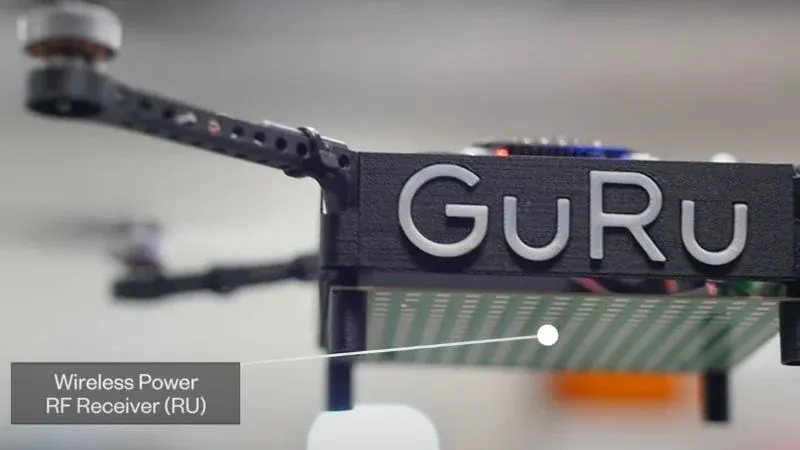
In a recent demonstration, GuRu Wireless used its wireless charging system to power an untethered drone 30 feet away. GuRu Wireless recently demonstrated its wireless power transfer system powering an untethered drone from 30 feet away. This demonstration highlighted the practicality of long-range energy transfer and how it integrates power delivery with communication. GuRu attached a recovery unit to the drone that worked with a transmitter to optimize power delivery dynamically, ensuring it received only the energy it needed. In the test, the drone operated for 96 hours without recharging—a game-changing improvement over the typical 30–45 minutes of drone operation time.
Guru wireless power transfer system
In GuRu lab, the team demonstrated its latest architecture with a transmitter configuration directly powering an untethered drone across 30 feet.
By focusing on modularity, efficiency, and long-range capabilities, GuRu claims its technology offers a scalable way to deliver power without relying on traditional methods like batteries or tethered systems.
GuRu's Wireless Energy Transfer
GuRu’s system uses high-frequency millimeter-wave radio signals instead of the usual inductive coupling in many wireless charging systems. Operating at 24 GHz, this approach can transfer energy over several kilometers. The system sends targeted beams of non-ionizing radio waves—similar to the frequencies used in 5G networks—to a receiving device.
This targeted energy transfer requires precision. The transmitter is equipped with proprietary radio frequency integrated circuits (RFICs) that are the "smallest 24-GHz modules in the industry." These modules are assembled into tiles, creating a phased array architecture that efficiently directs energy. A recovery unit on the receiving device communicates its location and power needs, ensuring accurate power delivery.
Modular and Synchronous
GuRu says its hardware is compact and adaptable. The system's modular design enables various configurations, which means the system’s tiles can be scaled and configured to suit different power and range requirements. Synchronization between transmitters eliminates inefficiencies to ensure that power delivery is highly targeted and efficient. Unlike older wireless charging systems that rely on coil alignment, GuRu’s technology removes the need for precise positioning, reducing energy loss and minimizing heat generation.
This modularity translates to flexibility across different industries and applications. For large-scale applications, such as powering industrial IoT networks or automotive charging stations, the system can be expanded by adding more tiles. Alternately, the recovery unit offers a lightweight and compact solution for smaller, space-constrained devices.
Perhaps one of GuRu's most anticipated applications is in drone operations. Here, wireless power transfer can keep surveillance and reconnaissance drones airborne for days. This has obvious security and operational efficiency advantages, especially in defense and environmental monitoring deployments.
The system also has potential for consumer electronics, where it could enable wireless charging of multiple devices in a room without requiring precise alignment. In the automotive sector, wireless charging stations could replace traditional plug-in chargers, offering greater convenience. Additionally, GuRu’s compact recovery unit is well-suited for applications with strict size and weight constraints, such as satellites or wearable medical devices.
A Promising Proof of Concept
By combining modularity, long-range capability, and efficient energy delivery, GuRu’s system addresses many challenges that have limited wireless power technologies in the past. Its targeted energy transfer eliminates the alignment issues common with older systems, while its phased array design minimizes power loss and interference with other devices.


